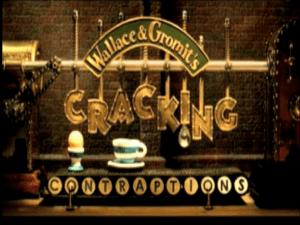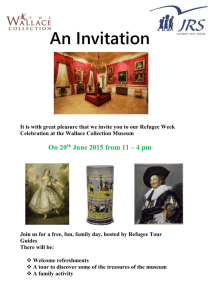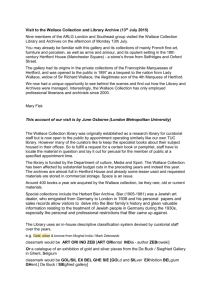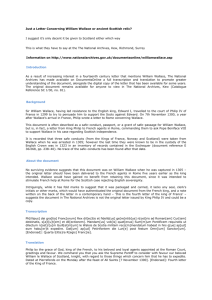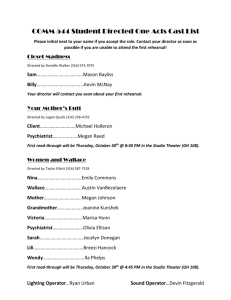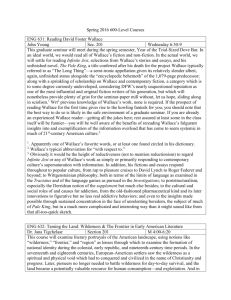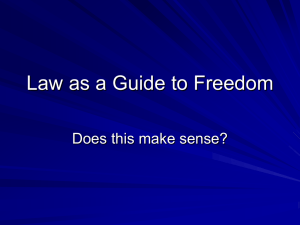a history of william vincent wallace
advertisement
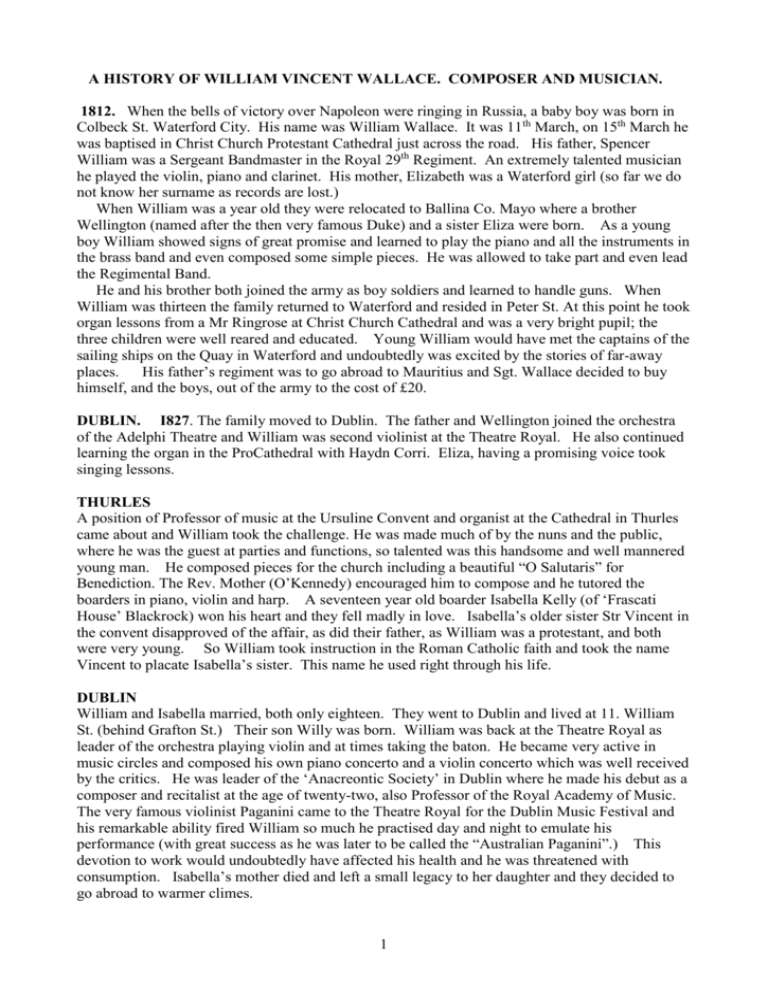
A HISTORY OF WILLIAM VINCENT WALLACE. COMPOSER AND MUSICIAN. 1812. When the bells of victory over Napoleon were ringing in Russia, a baby boy was born in Colbeck St. Waterford City. His name was William Wallace. It was 11th March, on 15th March he was baptised in Christ Church Protestant Cathedral just across the road. His father, Spencer William was a Sergeant Bandmaster in the Royal 29th Regiment. An extremely talented musician he played the violin, piano and clarinet. His mother, Elizabeth was a Waterford girl (so far we do not know her surname as records are lost.) When William was a year old they were relocated to Ballina Co. Mayo where a brother Wellington (named after the then very famous Duke) and a sister Eliza were born. As a young boy William showed signs of great promise and learned to play the piano and all the instruments in the brass band and even composed some simple pieces. He was allowed to take part and even lead the Regimental Band. He and his brother both joined the army as boy soldiers and learned to handle guns. When William was thirteen the family returned to Waterford and resided in Peter St. At this point he took organ lessons from a Mr Ringrose at Christ Church Cathedral and was a very bright pupil; the three children were well reared and educated. Young William would have met the captains of the sailing ships on the Quay in Waterford and undoubtedly was excited by the stories of far-away places. His father’s regiment was to go abroad to Mauritius and Sgt. Wallace decided to buy himself, and the boys, out of the army to the cost of £20. DUBLIN. I827. The family moved to Dublin. The father and Wellington joined the orchestra of the Adelphi Theatre and William was second violinist at the Theatre Royal. He also continued learning the organ in the ProCathedral with Haydn Corri. Eliza, having a promising voice took singing lessons. THURLES A position of Professor of music at the Ursuline Convent and organist at the Cathedral in Thurles came about and William took the challenge. He was made much of by the nuns and the public, where he was the guest at parties and functions, so talented was this handsome and well mannered young man. He composed pieces for the church including a beautiful “O Salutaris” for Benediction. The Rev. Mother (O’Kennedy) encouraged him to compose and he tutored the boarders in piano, violin and harp. A seventeen year old boarder Isabella Kelly (of ‘Frascati House’ Blackrock) won his heart and they fell madly in love. Isabella’s older sister Str Vincent in the convent disapproved of the affair, as did their father, as William was a protestant, and both were very young. So William took instruction in the Roman Catholic faith and took the name Vincent to placate Isabella’s sister. This name he used right through his life. DUBLIN William and Isabella married, both only eighteen. They went to Dublin and lived at 11. William St. (behind Grafton St.) Their son Willy was born. William was back at the Theatre Royal as leader of the orchestra playing violin and at times taking the baton. He became very active in music circles and composed his own piano concerto and a violin concerto which was well received by the critics. He was leader of the ‘Anacreontic Society’ in Dublin where he made his debut as a composer and recitalist at the age of twenty-two, also Professor of the Royal Academy of Music. The very famous violinist Paganini came to the Theatre Royal for the Dublin Music Festival and his remarkable ability fired William so much he practised day and night to emulate his performance (with great success as he was later to be called the “Australian Paganini”.) This devotion to work would undoubtedly have affected his health and he was threatened with consumption. Isabella’s mother died and left a small legacy to her daughter and they decided to go abroad to warmer climes. 1 AUSTRALIA. 1835. William, Isabella, her sister Anna and two year old baby Willy sailed from Dublin to start a new life and arrived in Hobart Tasmania many months later. William gave two concerts and then they decided to travel on to Sydney. New South Wales. The Governor General Sir Richard Bourke was Irish of an eminent and historic Limerick family and had an impressive record in the British Army. He and his family contributed greatly to the rise in cultural activities in Sydney and when William arrived his newly acquired reputation preceded him and within a month he gave his first celebrity concert under the patronage of Sir Richard Bourke which was repeated by public demand and he would give nearly twenty more concerts in the following two years. With his improvement in health and energy he would play his Violin Concerto in the first half and his Piano Concerto in the second and surprise the audience with an encore on the clarinet. He conducted many important and well known pieces, also in the Cathedral. The music loving public adored him. Not alone was he ‘Australia’s Paganini’ he was also likened to Lizst, his piano fingering was so light and dexterous. William loved everything beautiful including the society ladies that found him so fascinating, they would commission pieces of music dedicated to them on the artistic front covers. His charismatic charm and attention to etiquette was legendary. In Beedell’s words in the press “he was Sydney’s undisputed musical Emperor.” He set up the Royal Academy of Music and the Sydney Music Festival – which are still in existence. Another emigrant family from England came to Sydney and the father John Deane became a friendly rival for William and the two often joined forces in music. William’s mother had died before they emigrated and his father had married again. Father, his wife Matilda, two children and sister-in-law, Wellington, and Eliza all eventually went out to Sydney where they were all involved in teaching music, singing and the concerts. Eliza had a beautiful trained soprano voice and married a fine baritone John Bouchelle. He died and she was a widow at the tender age of twenty three, her son became a fine singer also and Madame Bouchelle reached considerable fame in her professional life. Isabella and William worked hard giving piano violin and singing lessons. Then Isabella received news from home, her father had died and her youngest sister was very ill. She badly wanted to go home and William gave a farewell concert, but he found it very hard to leave all his family and his new life, also the risk to his health back in Ireland, so with great sadness let his wife, her sister and his little son return home. He promised, and honoured, to support them for the rest of his life. However some time later there came a Recession and having imported pianos from London money had to be found. NEW ZEALAND. William decided to seek his fortune further afield and left Australia to pick up a sailing ship for South America via New Zealand. He took a whaling boat first and found himself in a mutiny on board. He and the ship’s cook – with whom the crew had no quarrel - were put off in a small boat. They were picked up by Maoris and taken to their King. The King’s daughter desired William (he had no doubt charmed them with his violin safely in his possession) and he either married her or he and his friend were in deep trouble. So they had a Maori marriage. As soon as a Trading Ship came around the two captives managed to escape, though the princess cut a large cross on William’s chest with her knife pursuing him, which in years to come he was to display the scar to those who didn’t believe his story. The news of this reached England and Dublin which would not have amused Isabella. INDIA. William’s second encounter with danger was in India en route across the globe where he took part in a tiger shoot. His co-hunter on the back of an elephant was King Leopold of Belgium. A tiger was springing toward Leopold who was saved by William’s shot (thanks to his military training.) 2 He was presented with a gold Hunter pocket watch by the King with a picture of the tiger shoot painted inside the case, he was also given a diamond ring which he always wore. SOUTH AMERICA William’s adventurous travels led him finally to the southern tip of South America. The trading ships took many months in transit as they called to load and unload cargo at the ports en route giving passengers time to discover the beautiful islands and William entertained with his violin and was received by Kings, Queens and Potentates, and often bestowed with precious jewels and gifts. Arriving in Valparaiso. Chile. In 1838 William became part of a British Colony where he started his concerts again. In the next few years he travelled extensively from place to place always giving concerts. He then crossed the Andes on a mule and would carry a bag of tobacco on his back for payments. He arrived in Buenos Aires, then on to Peru, Jamaica and Cuba. He played to packed theatres wherever he went, his fame again preceding him, and became a very wealthy man. Even then he could command $5,000 for a concert. In Mexico City he wrote a High Mass for the Cathedral and renewed his friendship with the Ursuline nuns. He fled the uprising there and eventually arrived in New Orleans where he conducted the French Theatre orchestra. Here he contracted a serious fever and rested for twelve months. Anther life threatening episode finds William on one of the big Paddle Steamers on the river where he was chatting on deck smoking his pipe standing near the funnel. Some ladies begged him to come below and play the piano in the Salon. Always obliging to the fair sex he did so. The funnel where he had been standing overheated and blew up causing enormous damage and loss of life. Once again he was saved. NORTH AMERICA When he was feeling well again he started his travels once more working his way up the east coast giving his now legendary concerts. He visited Philadelphia and up as far as Boston. His goal was New York and he finally settled there. He became very active in music circles and a distinguished figure. He was a founder member of the famous New York Philharmonic Society, and led a busy and rewarding life for some time, always composing. EUROPE. William decided to go to Europe where he travelled extensively with many royal invitations and concerts. He moved in the highest circles and enjoyed meeting his contemporary composers and leading musicians, learning styles of musical presentation. He met Rossini and Berlioz who were to become his life long friends. LONDON. 1845. Settling in London he met with Edward Fitzball a librettist at Drury Lane and they worked together on opera production. With the influence of Spanish South America William composed his first’ and most successful “Maritana”. This light opera was at once a resounding triumph. It ran for months on end and the beautiful music and arias were sung in every Victorian parlour and by every organ grinder or place of music. Another Irish composer at the time was his friendly rival Michael William Balfe. He presented Wallace with a charming inscribed snuff box on the opening night. There could be five or more curtain calls and Vincent Wallace became a household name. By 1847 “Maritana” was immensely successful in Europe, especially Vienna. His sister Eliza, now an experienced soprano sang the part of Maritana to delighted audiences. Wallace had a singular honour bestowed upon him by Queen Victoria. A special medallion was commissioned at the British Mint by the great artist Wier ( a side- view cameo of Wallace’s head) and five copies were struck and then the dye destroyed, a compliment never bestowed by a sovereign on a subject. One was sent to each of the following crowned heads 3 of Europe, The Tsar of Russia, the Emperor of Austria, and the King of Prussia, one was kept at Buckingham Palace and the remaining one given to Wallace himself which he presented to his Publishers Wm Hall and Son. New York. DUBLIN Wallace returned to Dublin where he was a guest of the Lord Lieutenant. He went to meet his wife Isabella but she would have nothing to do with him. He wrote many arrangements of Irish songs (including a very beautiful violin version of “The Last Rose of Summer”. Also a remarkable piano piece “Cracovienne” which he would play for his recitals. He returned to London again, and then he decided to go back to New York with “Maritana.” NEW YORK. 1850. Wallace revelled in his opera successes continuing his concerts. A lady of German origin, Helene Stoepel, who played for his concerts, became a close friend. Wallace took American citizenship so as to marry Helene. They had two sons, Clarence and Vincent. (Clarence composed music also in later life.) LONDON. 1853 – 64. Wallace went on to compose more operas. “Lurline” (the Spirit of the Rhine) also enjoyed immense success. “The Amber Witch”, “Love’s Triumph”, “Matilda of Hungary” and “Desert Flower” were his completed productions and all had varying triumphs. Both he and Helene worked hard and taught music as well. Their sons were well educated in London and Paris. FRANCE. 1865. William’s health and eyesight began to deteriorate and the family went to Passy in Paris for a year for medical attention. His constant companion was his old friend Rossini. Getting weaker he was moved to the Chateau de Bagen in the Pyranees owned by Helene’s sister and husband. And William died there. His body was brought to London for burial in Kensal Green Cemetery. Many famous people attended, there was no music but a robin sang throughout in the tree overhead, a touching tribute to the gentle and beauty loving man who dedicated his life to giving joy to thousands all over the world. Helene and the boys returned to America. The extended family have now been traced. William remained a loyal Irishman wherever he went, a focussed and hard working musician he died from a heart attack at the early age of 53, a great loss to the world of music. Footnote. ‘The Friends of Wallace’ Waterford Ireland. had a headstone erected on his grave, which was in bad state of deterioration. C.Ds have been made of “Maritana” “Lurline” and his piano music and Variations. Waterford City Council erected a Plaza in his name on the Waterford City Quayside. The Music Room in the Bishop’s Palace Museum is dedicated to William Vincent Wallace. He is remembered and honoured in his birthplace. A most famous son of Waterford. Maureen FitzGerald. Hon Sec. ‘Friends of Wallace.’ Richard FitzGerald. Researcher. ‘Friends of Wallace.’ Robert Phelan. Chmn. Researcher ‘Friends of Wallace.’ Author of “William Vincent Wallace. A Vagabond Composer”. 4
